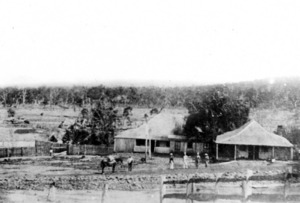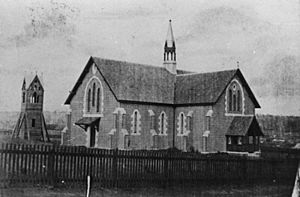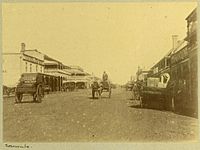History of Toowoomba, Queensland facts for kids
The modern history of Toowoomba began in the 1800s. European explorers and settlers started arriving in the area from 1816. By the late 1840s, the rich land around Toowoomba was being used for farming. Small towns began to grow, with schools and churches being built. Toowoomba held its first council election in 1861, and a telegraph connection to Brisbane was set up in 1862. Many new railway lines opened from Toowoomba between 1868 and 1886. In the 21st century, the city continued to grow with new hospitals, large industrial buildings, and schools. The Toowoomba Wellcamp Airport opened in 2014.
Contents
What's in a Name?
How Toowoomba got its name is still a bit of a mystery! There are a few ideas:
- Some say it comes from an Aboriginal word for "swamp," which was Tawampa. Aboriginal languages didn't have an "s" sound.
- Another idea is that it came from the Aboriginal phrase Woomba Woomba, meaning "reeds in the swamp."
- A third theory suggests the name came from an Aboriginal word for a native melon, "Toowoom" or "Choowoom," which grew a lot in the area.
Early Explorers (1800-1820)
In 1816, an English botanist and explorer named Allan Cunningham came to Australia. He had been collecting plants in Brazil for Joseph Banks, a famous scientist. Cunningham was the first European to visit the land we now know as Toowoomba.
Settling the Land (1820-1840)
In June 1827, Allan Cunningham made an important discovery. He found a huge area of rich land, about 4 million acres (16,000 square kilometers), perfect for farming and raising animals. This land was east of the Great Dividing Range and about 160 kilometers west of Moreton Bay (which later became Brisbane). Cunningham named this area the Darling Downs after Ralph Darling, who was the Governor of New South Wales at the time.
Thirteen years later, the first settlers arrived on the Downs. George and Patrick Leslie set up Toolburra Station, about 90 kilometers southwest of Toowoomba. Other settlers, like Thomas Alford, soon followed. Some tradesmen and business people also settled and started a small town of bark-slab shops. They called it The Springs, but it was soon renamed Drayton.
Drayton Grows and Toowoomba Begins (1840-1860)
By the late 1840s, Drayton had grown quite a bit. It had its own newspaper, a general store, a trading post, and the Royal Bull's Head Inn. William Horton built this inn, and it's still standing today! Many people see Horton as the true founder of Toowoomba, even though he wasn't the very first European to live there.
In early 1849, Horton sent two of his workers to clear reeds in a swampy area a few miles away. This swamp was a place nobody from Drayton ever visited. When the workers arrived, they were surprised to find a tent among the reeds. The tent belonged to Josiah Dent, who was the first person to live in "The Swamp." This news spread quickly in Drayton, and people became interested in using the swamp land for farming. Plans were made for 12 to 20-acre farms in the swamp. The idea was to attract more people to the area and help the town grow. Two years later, people started buying this land, but they were mostly buyers from Drayton, not new settlers.
By 1858, Toowoomba was growing fast. It had about 700 people, three hotels, and many stores. Land that sold for £4 an acre in 1850 was now selling for £150 an acre!
In 1851, the first school in Drayton opened, which later became Drayton State School. On August 29, 1852, the local church leader, Reverend Benjamin Glennie, held the first Church of England service in Toowoomba. This was also the first time the word "Toowoomba" was written on a public document.
In 1853, the Queensland Government gave 2 acres of land for a Presbyterian church, school, and house. This was on the corner of James Street and Hume Street in what is now East Toowoomba. A church building was finished on September 11, 1859. It was used by visiting ministers until 1863, when William Lambie Nelson became the first official Presbyterian minister in Toowoomba.
Toowoomba Becomes a Town (1860-1880)
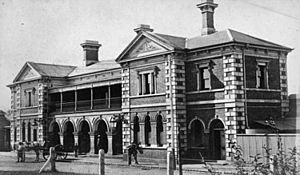
On June 30, 1860, 100 people signed a request asking the Queensland Governor to declare Toowoomba a Municipality (its own local government area). Governor George Bowen agreed, and the new municipality was officially announced on November 24, 1860. The first town council election happened on January 4, 1861. William Henry Groom, who had led the effort for Toowoomba to be recognized, received the most votes. Later, on August 12, 1862, Alderman Groom was elected to the Queensland Legislative Assembly as a representative for Drayton and Toowoomba.
Also in August 1862, Toowoomba got a telegraph connection to Brisbane, making communication much faster.
In 1864, Toowoomba Gaol (a jail) was opened.
In 1865, Toowoomba South State School opened. This was the first State School within Toowoomba itself.
In April 1867, Toowoomba's railway line to Ipswich was opened.
In 1870, Alderman Spiro became Mayor, replacing William Henry Groom. In 1873, the Council gained control of the swamp area and offered a prize for the best way to drain it.
The Toowoomba Gas and Coke Company started in 1875. The Council promised to put up street lamps to help the new company get started. Because of money issues, the Council leased part of the swamp to brickmakers in the town.
The Council also approved the building of the Toowoomba Grammar School. The foundation stone for the school was laid in 1875.
| Railway Lines from Toowoomba | |||
|---|---|---|---|
| To | Line | Opened | Closed |
| Dalby | Western | 1868 | - |
| Warwick | Southern | 1871 | - |
| Miles | Western | 1878 | - |
| Cabarlah | Crows Nest | 1883 | 1961 |
| Crows Nest | Crows Nest | 1886 | 1961 |
Becoming a City (1880-1920)
In 1892, Toowoomba and the areas around it were officially declared a township.
By 1898, the existing Town Hall was too small for the growing community. In July, the Council decided that new municipal buildings and a Town Hall should be built. They chose the site of the School of Arts, which had been destroyed by fire earlier that year.
The Council offered a prize of 25 guineas for the best design for the new Town Hall. Architect Willoughby Powell's design won, and the contract to build it for £10,000 went to Alexander Mayes, who later became Mayor. The new building opened in 1900 and is still on Ruthven Street today. It was updated in 1996, and Council meetings are held there again.
The Trevethan, a car with one cylinder, was built in Toowoomba.
At noon on October 20, 1904, Toowoomba's status changed from a township to a city! Every bell and horn in the city sounded for half a minute to celebrate this big event.
A suburban rail motor service started in May 1917, running to Wyreema, about 16 kilometers away. It was later extended to Cambooya and Willowburn in 1918. These services stopped around 1923.
Growth and Change (1920-1950)
Downlands College, a well-known school, opened in 1931.
During World War II, many American and Australian troops came to Toowoomba. They used the city's parks and major buildings for recreation, hospitals, and training.
Modern Toowoomba (1950-2010s)
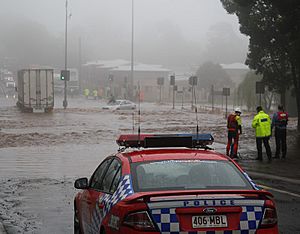
Since the 1950s, Toowoomba has grown to offer more services. Besides being a center for business, farming, and education, it now has higher education facilities, military bases, and government departments.
Nellie E. Robinson made history in 1961 when she was elected as Queensland's first female mayor for the City of Toowoomba.
A center for higher education, the QITDD, was started in Toowoomba in 1967. It later became the Darling Downs Institute of Advanced Education (DDIAE) in 1971, then a university college (UCSQ) in 1990, and finally the University of Southern Queensland (USQ).
In the years that followed, Toowoomba saw its first high-rise buildings being constructed. This showed the city's growing population and economy.
In January 2011, the city was badly affected by flash floods. Parts of the city center along Gowrie Creek were hit especially hard, and some people sadly lost their lives.
In 2013, a local construction company, Wagners, built Australia's first privately owned airport that could handle jet planes. This was also the first airport in Toowoomba's history: Toowoomba Wellcamp Airport.
In 2014, the Australian Government announced the long-awaited Toowoomba Second Range Crossing. This was the largest regional infrastructure project in Queensland's history.


